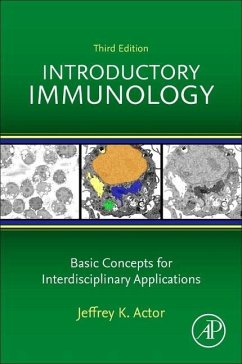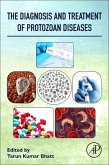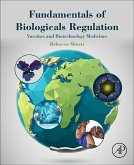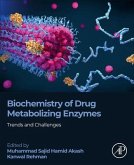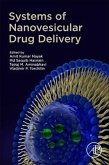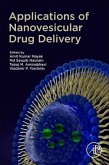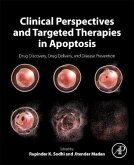- Broschiertes Buch
- Merkliste
- Auf die Merkliste
- Bewerten Bewerten
- Teilen
- Produkt teilen
- Produkterinnerung
- Produkterinnerung
Revised edition of: Introductory immunology / Jeffrey K. Actor. Second edition. [2019].
Andere Kunden interessierten sich auch für
![The Diagnosis and Treatment of Protozoan Diseases The Diagnosis and Treatment of Protozoan Diseases]() The Diagnosis and Treatment of Protozoan Diseases181,99 €
The Diagnosis and Treatment of Protozoan Diseases181,99 €![Fundamentals of Biologicals Regulation Fundamentals of Biologicals Regulation]() Rebecca SheetsFundamentals of Biologicals Regulation162,99 €
Rebecca SheetsFundamentals of Biologicals Regulation162,99 €![Biochemistry of Drug Metabolizing Enzymes Biochemistry of Drug Metabolizing Enzymes]() Biochemistry of Drug Metabolizing Enzymes189,99 €
Biochemistry of Drug Metabolizing Enzymes189,99 €![Systems of Nanovesicular Drug Delivery Systems of Nanovesicular Drug Delivery]() Systems of Nanovesicular Drug Delivery216,99 €
Systems of Nanovesicular Drug Delivery216,99 €![Primer on Cerebrovascular Diseases Primer on Cerebrovascular Diseases]() K. M. M.A. Welch / Louis R. Caplan / Donald J. Reis / Bo K. Siesjo / Bruce Weir (eds.)Primer on Cerebrovascular Diseases222,99 €
K. M. M.A. Welch / Louis R. Caplan / Donald J. Reis / Bo K. Siesjo / Bruce Weir (eds.)Primer on Cerebrovascular Diseases222,99 €![Applications of Nanovesicular Drug Delivery Applications of Nanovesicular Drug Delivery]() Applications of Nanovesicular Drug Delivery216,99 €
Applications of Nanovesicular Drug Delivery216,99 €![Clinical Perspectives and Targeted Therapies in Apoptosis Clinical Perspectives and Targeted Therapies in Apoptosis]() Clinical Perspectives and Targeted Therapies in Apoptosis207,99 €
Clinical Perspectives and Targeted Therapies in Apoptosis207,99 €-
-
-
Revised edition of: Introductory immunology / Jeffrey K. Actor. Second edition. [2019].
Hinweis: Dieser Artikel kann nur an eine deutsche Lieferadresse ausgeliefert werden.
Hinweis: Dieser Artikel kann nur an eine deutsche Lieferadresse ausgeliefert werden.
Produktdetails
- Produktdetails
- Verlag: Elsevier Science
- 3rd edition
- Seitenzahl: 224
- Erscheinungstermin: 6. Februar 2023
- Englisch
- Abmessung: 225mm x 150mm x 12mm
- Gewicht: 372g
- ISBN-13: 9780443153075
- ISBN-10: 0443153078
- Artikelnr.: 65693788
- Verlag: Elsevier Science
- 3rd edition
- Seitenzahl: 224
- Erscheinungstermin: 6. Februar 2023
- Englisch
- Abmessung: 225mm x 150mm x 12mm
- Gewicht: 372g
- ISBN-13: 9780443153075
- ISBN-10: 0443153078
- Artikelnr.: 65693788
Jeffrey K. Actor, PhD, is a professor and Medical Immunology Course Director in the Department of Pathology and Laboratory Medicine at the McGovern Medical School at the University of Texas Health Center at Houston. Dr. Actor received his PhD degree from the University of Massachusetts. His research interests include examination of host immune responses during pathogenic disease, understanding proinflammatory and regulatory cytokines during mycobacterial infections, vaccine development, and molecular mechanisms of adjuvant-induced immunomodulation. Professor Actor has established himself as a productive educator-scientist with a strong background in immunology and molecular biology with a broad range of expertise in pathobiology. He has shown his commitment to education and excellence, at both the Medical School and Graduate School levels.
Preface Acknowledgments
1. A functional overview of the immune system and components Chapter focus
Immune homeostasis Self versus nonself Innate and adaptive immunity Anatomy
of the immune system Cells of the immune system First-line defenders: the
myeloid cells Adaptive avengers: the lymphoid cells Lymphocytes Cluster of
differentiation Summary
2. The inflammatory response Chapter focus Inflammation Initiation of the
inflammatory response The role of antibodies in inflammation Biological
functions of complement Activation and directed migration of leukocytes
Pathogen recognition and cytokine signaling Feedback and adaptation from a
distance Pathological consequences of the inflammatory Response Summary
3. The B lymphocyte: antibodies and how they function Chapter focus B
lymphocytes produce antibodies Structural characteristics of
immunoglobulins Immunoglobulin nomenclature Biologic properties of antibody
isotypes IgD IgM IgG IgA IgE Kinetics of antibody response Membrane-bound
immunoglobulin Development of B cells Antibody gene recombination
Development and selection of mature B cells Activation and differentiation
of B cells Summary
4. T lymphocytes: ringleaders of adaptive immune function Chapter focus T
lymphocytes: specific and long-lasting immunity The T cell receptor T-cell
development Antigen recognition by T cells: requirement of major
histocompatibility molecules The HLA locus MHC class I MHC class II T
lymphocyte functions CD4 1 T-helper cells Events involved in T lymphocyte
activation Role of T cells in B-cell activation Cytotoxic T-cell effectors
CD8 1 T cells Other lymphocyte phenotypes ?d T cells Innate lymphocytes
Natural killer T (NKT) cells Superantigens Summary
5. How we defend against infectious agents Chapter focus Immune homeostasis
and pathogenic organisms Major immune defense mechanisms against pathogens
Physical barriers to infection Anatomic barrier Physiological barrier
Phagocytic and endocytic barriers Inflammatory barriers Bacterial
infections Microbial motifs detected through pattern-recognition receptors
Mycobacterial infections Viral infections Human immunodeficiency virus
Parasitic infections (helminths) Fungal infections Evasion of immune
response Summary
6. Basic disorders of immune function Chapter focus Immunodeficiency
disorders Genetic basis for primary immunodeficiency Innate deficiencies
Chronic granulomatous disease/myeloperoxidase deficiency Leukocyte adhesion
deficiency Chediak
Selective immunoglobulin A deficiency Common variable immunodeficiency
Hyper immunoglobulin M disorders DiGeorge syndrome Wiskott
Immunodeficiency as a predisposition to disease Human immunodeficiency
virus and acquired immunodeficiency syndrome Summary
7. Autoimmunity: regulation of response to self Chapter focus Homeostasis,
immune regulation, and autoimmunity Tolerance to self Etiology of
autoimmune disease Role of autoantibodies and self-reactive T lymphocytes
in autoimmune disorders Laboratory tests for autoimmunity Targeted
therapeutics Summary
8. Immune hypersensitivities Chapter focus Hypersensitive disorders Type I
hypersensitivity: immunoglobulin E
hypersensitivity: immune complex-mediated hypersensitivity Type IV
hypersensitivity: delayed-type (cell-mediated) hypersensitivity Alternative
hypersensitivity classifications Summary
9. Vaccines and immunotherapy Chapter focus Principles of vaccination Basic
concepts of protective immunization Types of immunizations Age and timing
of immunizations Vaccine types and components Immunologic adjuvants Passive
immunization Therapeutic uses of immunoglobulins Other ways to modify
immunity Summary
10. Cancer immunology Chapter focus Understanding immune defenses against
cancers Tumor antigens Effector mechanisms in tumor immunity Natural killer
cells and innate response to tumor cells Adaptive response to tumor cells
Escape mechanisms of tumor elimination Tumors of the immune system
Immunodiagnosis and immunotherapy Summary
11. Transplantation immunology Chapter focus Transplantation defined Tissue
histocompatibility Natural isohemagglutinins Human leukocyte antigens
Allograft rejection Hyperacute rejection Accelerated rejection Acute
rejection Chronic rejection Graft-versus-host disease Pretransplantation
histocompatibility evaluation Immunosuppressive drugs to prevent allograft
rejection Immunosuppressive therapy Summary
12. Assessment of immune parameters and immunodiagnostics Chapter focus
Antibody
agglutination Lateral flow Western blot Immunoassays Enzyme-linked
immunoadsorbent assay Detection of cellular antigens Immunohistochemistry
Fluorescence-activated cell sorting analysis Multiplex bead arrays Assays
to determine immune function Complement fixation test Phagocyte function
assays Lymphocyte function assays Other tools to measure immunological
status Monoclonal antibodies Microarrays Summary Glossary Index
1. A functional overview of the immune system and components Chapter focus
Immune homeostasis Self versus nonself Innate and adaptive immunity Anatomy
of the immune system Cells of the immune system First-line defenders: the
myeloid cells Adaptive avengers: the lymphoid cells Lymphocytes Cluster of
differentiation Summary
2. The inflammatory response Chapter focus Inflammation Initiation of the
inflammatory response The role of antibodies in inflammation Biological
functions of complement Activation and directed migration of leukocytes
Pathogen recognition and cytokine signaling Feedback and adaptation from a
distance Pathological consequences of the inflammatory Response Summary
3. The B lymphocyte: antibodies and how they function Chapter focus B
lymphocytes produce antibodies Structural characteristics of
immunoglobulins Immunoglobulin nomenclature Biologic properties of antibody
isotypes IgD IgM IgG IgA IgE Kinetics of antibody response Membrane-bound
immunoglobulin Development of B cells Antibody gene recombination
Development and selection of mature B cells Activation and differentiation
of B cells Summary
4. T lymphocytes: ringleaders of adaptive immune function Chapter focus T
lymphocytes: specific and long-lasting immunity The T cell receptor T-cell
development Antigen recognition by T cells: requirement of major
histocompatibility molecules The HLA locus MHC class I MHC class II T
lymphocyte functions CD4 1 T-helper cells Events involved in T lymphocyte
activation Role of T cells in B-cell activation Cytotoxic T-cell effectors
CD8 1 T cells Other lymphocyte phenotypes ?d T cells Innate lymphocytes
Natural killer T (NKT) cells Superantigens Summary
5. How we defend against infectious agents Chapter focus Immune homeostasis
and pathogenic organisms Major immune defense mechanisms against pathogens
Physical barriers to infection Anatomic barrier Physiological barrier
Phagocytic and endocytic barriers Inflammatory barriers Bacterial
infections Microbial motifs detected through pattern-recognition receptors
Mycobacterial infections Viral infections Human immunodeficiency virus
Parasitic infections (helminths) Fungal infections Evasion of immune
response Summary
6. Basic disorders of immune function Chapter focus Immunodeficiency
disorders Genetic basis for primary immunodeficiency Innate deficiencies
Chronic granulomatous disease/myeloperoxidase deficiency Leukocyte adhesion
deficiency Chediak
Selective immunoglobulin A deficiency Common variable immunodeficiency
Hyper immunoglobulin M disorders DiGeorge syndrome Wiskott
Immunodeficiency as a predisposition to disease Human immunodeficiency
virus and acquired immunodeficiency syndrome Summary
7. Autoimmunity: regulation of response to self Chapter focus Homeostasis,
immune regulation, and autoimmunity Tolerance to self Etiology of
autoimmune disease Role of autoantibodies and self-reactive T lymphocytes
in autoimmune disorders Laboratory tests for autoimmunity Targeted
therapeutics Summary
8. Immune hypersensitivities Chapter focus Hypersensitive disorders Type I
hypersensitivity: immunoglobulin E
hypersensitivity: immune complex-mediated hypersensitivity Type IV
hypersensitivity: delayed-type (cell-mediated) hypersensitivity Alternative
hypersensitivity classifications Summary
9. Vaccines and immunotherapy Chapter focus Principles of vaccination Basic
concepts of protective immunization Types of immunizations Age and timing
of immunizations Vaccine types and components Immunologic adjuvants Passive
immunization Therapeutic uses of immunoglobulins Other ways to modify
immunity Summary
10. Cancer immunology Chapter focus Understanding immune defenses against
cancers Tumor antigens Effector mechanisms in tumor immunity Natural killer
cells and innate response to tumor cells Adaptive response to tumor cells
Escape mechanisms of tumor elimination Tumors of the immune system
Immunodiagnosis and immunotherapy Summary
11. Transplantation immunology Chapter focus Transplantation defined Tissue
histocompatibility Natural isohemagglutinins Human leukocyte antigens
Allograft rejection Hyperacute rejection Accelerated rejection Acute
rejection Chronic rejection Graft-versus-host disease Pretransplantation
histocompatibility evaluation Immunosuppressive drugs to prevent allograft
rejection Immunosuppressive therapy Summary
12. Assessment of immune parameters and immunodiagnostics Chapter focus
Antibody
agglutination Lateral flow Western blot Immunoassays Enzyme-linked
immunoadsorbent assay Detection of cellular antigens Immunohistochemistry
Fluorescence-activated cell sorting analysis Multiplex bead arrays Assays
to determine immune function Complement fixation test Phagocyte function
assays Lymphocyte function assays Other tools to measure immunological
status Monoclonal antibodies Microarrays Summary Glossary Index
Preface Acknowledgments
1. A functional overview of the immune system and components Chapter focus
Immune homeostasis Self versus nonself Innate and adaptive immunity Anatomy
of the immune system Cells of the immune system First-line defenders: the
myeloid cells Adaptive avengers: the lymphoid cells Lymphocytes Cluster of
differentiation Summary
2. The inflammatory response Chapter focus Inflammation Initiation of the
inflammatory response The role of antibodies in inflammation Biological
functions of complement Activation and directed migration of leukocytes
Pathogen recognition and cytokine signaling Feedback and adaptation from a
distance Pathological consequences of the inflammatory Response Summary
3. The B lymphocyte: antibodies and how they function Chapter focus B
lymphocytes produce antibodies Structural characteristics of
immunoglobulins Immunoglobulin nomenclature Biologic properties of antibody
isotypes IgD IgM IgG IgA IgE Kinetics of antibody response Membrane-bound
immunoglobulin Development of B cells Antibody gene recombination
Development and selection of mature B cells Activation and differentiation
of B cells Summary
4. T lymphocytes: ringleaders of adaptive immune function Chapter focus T
lymphocytes: specific and long-lasting immunity The T cell receptor T-cell
development Antigen recognition by T cells: requirement of major
histocompatibility molecules The HLA locus MHC class I MHC class II T
lymphocyte functions CD4 1 T-helper cells Events involved in T lymphocyte
activation Role of T cells in B-cell activation Cytotoxic T-cell effectors
CD8 1 T cells Other lymphocyte phenotypes ?d T cells Innate lymphocytes
Natural killer T (NKT) cells Superantigens Summary
5. How we defend against infectious agents Chapter focus Immune homeostasis
and pathogenic organisms Major immune defense mechanisms against pathogens
Physical barriers to infection Anatomic barrier Physiological barrier
Phagocytic and endocytic barriers Inflammatory barriers Bacterial
infections Microbial motifs detected through pattern-recognition receptors
Mycobacterial infections Viral infections Human immunodeficiency virus
Parasitic infections (helminths) Fungal infections Evasion of immune
response Summary
6. Basic disorders of immune function Chapter focus Immunodeficiency
disorders Genetic basis for primary immunodeficiency Innate deficiencies
Chronic granulomatous disease/myeloperoxidase deficiency Leukocyte adhesion
deficiency Chediak
Selective immunoglobulin A deficiency Common variable immunodeficiency
Hyper immunoglobulin M disorders DiGeorge syndrome Wiskott
Immunodeficiency as a predisposition to disease Human immunodeficiency
virus and acquired immunodeficiency syndrome Summary
7. Autoimmunity: regulation of response to self Chapter focus Homeostasis,
immune regulation, and autoimmunity Tolerance to self Etiology of
autoimmune disease Role of autoantibodies and self-reactive T lymphocytes
in autoimmune disorders Laboratory tests for autoimmunity Targeted
therapeutics Summary
8. Immune hypersensitivities Chapter focus Hypersensitive disorders Type I
hypersensitivity: immunoglobulin E
hypersensitivity: immune complex-mediated hypersensitivity Type IV
hypersensitivity: delayed-type (cell-mediated) hypersensitivity Alternative
hypersensitivity classifications Summary
9. Vaccines and immunotherapy Chapter focus Principles of vaccination Basic
concepts of protective immunization Types of immunizations Age and timing
of immunizations Vaccine types and components Immunologic adjuvants Passive
immunization Therapeutic uses of immunoglobulins Other ways to modify
immunity Summary
10. Cancer immunology Chapter focus Understanding immune defenses against
cancers Tumor antigens Effector mechanisms in tumor immunity Natural killer
cells and innate response to tumor cells Adaptive response to tumor cells
Escape mechanisms of tumor elimination Tumors of the immune system
Immunodiagnosis and immunotherapy Summary
11. Transplantation immunology Chapter focus Transplantation defined Tissue
histocompatibility Natural isohemagglutinins Human leukocyte antigens
Allograft rejection Hyperacute rejection Accelerated rejection Acute
rejection Chronic rejection Graft-versus-host disease Pretransplantation
histocompatibility evaluation Immunosuppressive drugs to prevent allograft
rejection Immunosuppressive therapy Summary
12. Assessment of immune parameters and immunodiagnostics Chapter focus
Antibody
agglutination Lateral flow Western blot Immunoassays Enzyme-linked
immunoadsorbent assay Detection of cellular antigens Immunohistochemistry
Fluorescence-activated cell sorting analysis Multiplex bead arrays Assays
to determine immune function Complement fixation test Phagocyte function
assays Lymphocyte function assays Other tools to measure immunological
status Monoclonal antibodies Microarrays Summary Glossary Index
1. A functional overview of the immune system and components Chapter focus
Immune homeostasis Self versus nonself Innate and adaptive immunity Anatomy
of the immune system Cells of the immune system First-line defenders: the
myeloid cells Adaptive avengers: the lymphoid cells Lymphocytes Cluster of
differentiation Summary
2. The inflammatory response Chapter focus Inflammation Initiation of the
inflammatory response The role of antibodies in inflammation Biological
functions of complement Activation and directed migration of leukocytes
Pathogen recognition and cytokine signaling Feedback and adaptation from a
distance Pathological consequences of the inflammatory Response Summary
3. The B lymphocyte: antibodies and how they function Chapter focus B
lymphocytes produce antibodies Structural characteristics of
immunoglobulins Immunoglobulin nomenclature Biologic properties of antibody
isotypes IgD IgM IgG IgA IgE Kinetics of antibody response Membrane-bound
immunoglobulin Development of B cells Antibody gene recombination
Development and selection of mature B cells Activation and differentiation
of B cells Summary
4. T lymphocytes: ringleaders of adaptive immune function Chapter focus T
lymphocytes: specific and long-lasting immunity The T cell receptor T-cell
development Antigen recognition by T cells: requirement of major
histocompatibility molecules The HLA locus MHC class I MHC class II T
lymphocyte functions CD4 1 T-helper cells Events involved in T lymphocyte
activation Role of T cells in B-cell activation Cytotoxic T-cell effectors
CD8 1 T cells Other lymphocyte phenotypes ?d T cells Innate lymphocytes
Natural killer T (NKT) cells Superantigens Summary
5. How we defend against infectious agents Chapter focus Immune homeostasis
and pathogenic organisms Major immune defense mechanisms against pathogens
Physical barriers to infection Anatomic barrier Physiological barrier
Phagocytic and endocytic barriers Inflammatory barriers Bacterial
infections Microbial motifs detected through pattern-recognition receptors
Mycobacterial infections Viral infections Human immunodeficiency virus
Parasitic infections (helminths) Fungal infections Evasion of immune
response Summary
6. Basic disorders of immune function Chapter focus Immunodeficiency
disorders Genetic basis for primary immunodeficiency Innate deficiencies
Chronic granulomatous disease/myeloperoxidase deficiency Leukocyte adhesion
deficiency Chediak
Selective immunoglobulin A deficiency Common variable immunodeficiency
Hyper immunoglobulin M disorders DiGeorge syndrome Wiskott
Immunodeficiency as a predisposition to disease Human immunodeficiency
virus and acquired immunodeficiency syndrome Summary
7. Autoimmunity: regulation of response to self Chapter focus Homeostasis,
immune regulation, and autoimmunity Tolerance to self Etiology of
autoimmune disease Role of autoantibodies and self-reactive T lymphocytes
in autoimmune disorders Laboratory tests for autoimmunity Targeted
therapeutics Summary
8. Immune hypersensitivities Chapter focus Hypersensitive disorders Type I
hypersensitivity: immunoglobulin E
hypersensitivity: immune complex-mediated hypersensitivity Type IV
hypersensitivity: delayed-type (cell-mediated) hypersensitivity Alternative
hypersensitivity classifications Summary
9. Vaccines and immunotherapy Chapter focus Principles of vaccination Basic
concepts of protective immunization Types of immunizations Age and timing
of immunizations Vaccine types and components Immunologic adjuvants Passive
immunization Therapeutic uses of immunoglobulins Other ways to modify
immunity Summary
10. Cancer immunology Chapter focus Understanding immune defenses against
cancers Tumor antigens Effector mechanisms in tumor immunity Natural killer
cells and innate response to tumor cells Adaptive response to tumor cells
Escape mechanisms of tumor elimination Tumors of the immune system
Immunodiagnosis and immunotherapy Summary
11. Transplantation immunology Chapter focus Transplantation defined Tissue
histocompatibility Natural isohemagglutinins Human leukocyte antigens
Allograft rejection Hyperacute rejection Accelerated rejection Acute
rejection Chronic rejection Graft-versus-host disease Pretransplantation
histocompatibility evaluation Immunosuppressive drugs to prevent allograft
rejection Immunosuppressive therapy Summary
12. Assessment of immune parameters and immunodiagnostics Chapter focus
Antibody
agglutination Lateral flow Western blot Immunoassays Enzyme-linked
immunoadsorbent assay Detection of cellular antigens Immunohistochemistry
Fluorescence-activated cell sorting analysis Multiplex bead arrays Assays
to determine immune function Complement fixation test Phagocyte function
assays Lymphocyte function assays Other tools to measure immunological
status Monoclonal antibodies Microarrays Summary Glossary Index
